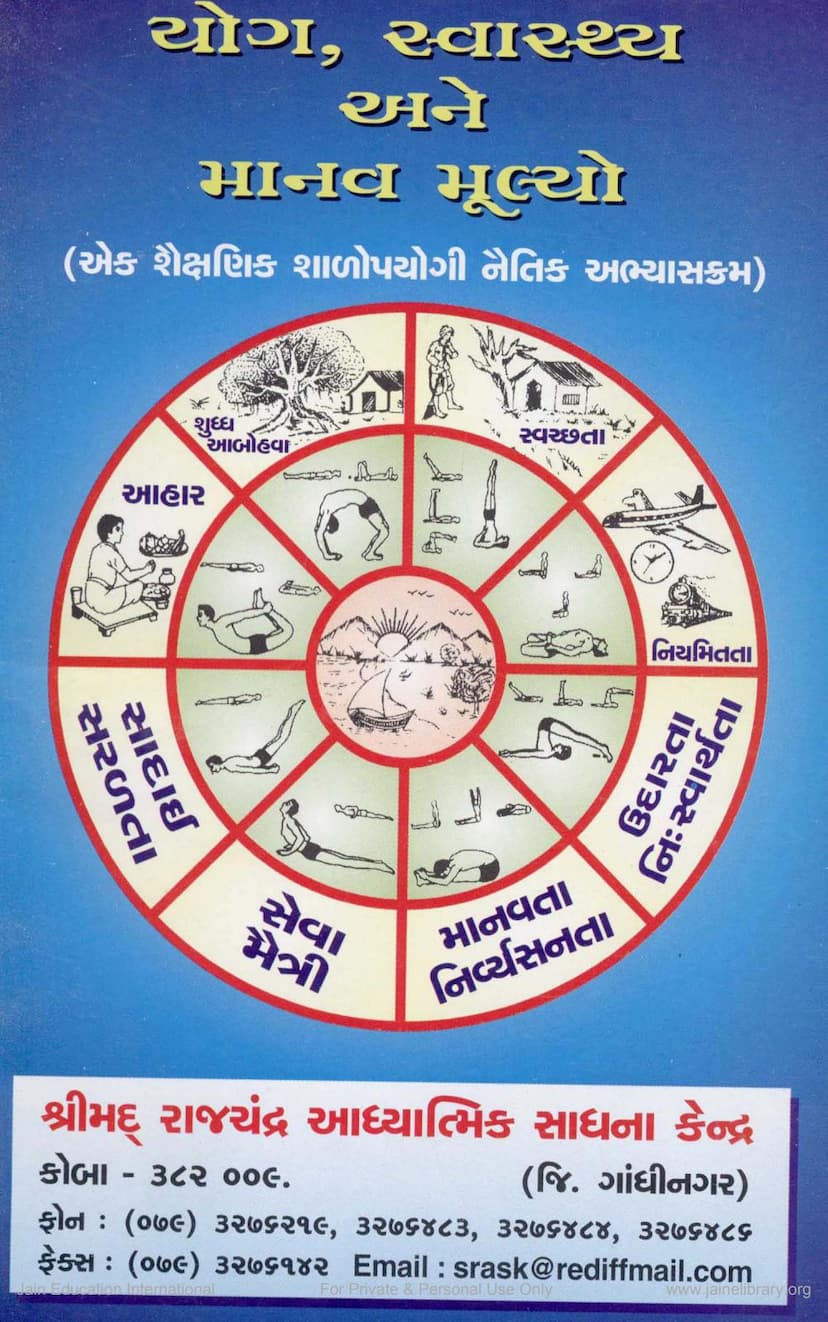Yoga Swasthya Ane Manav Mulyo
Added to library: September 2, 2025

Summary
This document is a Jain text titled "Yoga, Health, and Human Values" (Yoga Swasthya ane Manav Mulyo) authored by Atmanandji Maharaj and published by Shrimad Rajchandra Sadhna Kendra Koba. It's presented as an educational and ethical curriculum for schools.
The book emphasizes the importance of a holistic approach to life, focusing on physical well-being (health and yoga), moral development (human values), and spiritual upliftment.
Here's a breakdown of its key themes and content:
Core Principles and Values:
- Holistic Well-being: The book argues that true success in human life requires a healthy body, truthful and sweet speech, a joyful mind, and a soul radiant with virtues.
- Modern Discontent: It notes that despite material advancements, modern humans are restless and fearful because they haven't properly cultivated these fundamental inner qualities.
- Yoga and Health: Yoga is presented as a path to physical, mental, and spiritual health. It aims to connect individuals with peace and knowledge.
- Human Values: The text highlights key values such as purity of climate, proper diet, simplicity, service, friendship, cleanliness, humanity, abstinence from vices, regularity, generosity, and peace.
- Spiritual Foundation: The publisher's core mission is to promote spiritual knowledge and practice, with a particular emphasis on the teachings of Shrimad Rajchandra.
Content Structure and Focus:
The book is structured into lessons designed for sequential learning, covering:
- Introduction to Human Personality: Discusses the external (physical) and internal (mental) aspects of human personality and the need for balanced development.
- The Essence of Yoga: Defines yoga in various ways: connection, union of soul with the divine, skill in action, and harmony with oneself and the world. It also presents guiding principles for practicing yoga and inspiring verses.
- The Eight Limbs of Yoga (Astanga Yoga): While the book mentions the eight limbs, it primarily focuses on:
- Yama (Restraints): Non-violence (Ahimsa), Truthfulness (Satya), Non-stealing (Achaurya), Celibacy/Chastity (Brahmacharya), and Non-possessiveness/Non-attachment (Aparigraha). The text elaborates on the meaning of each in a general citizen's life.
- Niyama (Observances): Purity (Shaucha), Contentment (Santosha), Austerity/Penance (Tapa), Self-study (Swadhyaya), and Surrender to the Divine (Ishwar Pranidhan).
- Asana (Postures): This section is extensively detailed, categorizing asanas into:
- Asanas for Health: Many specific asanas are described with their postures, actions, benefits, and timings, including Gomukhasana, Vakrasana, Ushtrasana, Janushirasana, Uttanapadasana, Pavanamuktasana, Kati-Uttanasana, Sarvangasana, Halasana, Hast Bhujangasana, Shalabhasana, Dhanurasana, Trikonasana, Garudasana, Utkatasana, and Shirshasana.
- Asanas for Meditation: Padmasana (Lotus Pose) and Vajrasana (Thunderbolt Pose) are detailed as aids for concentration and meditation.
- Asanas for Relaxation: Shavasana (Corpse Pose), Makarasana (Crocodile Pose), and Balasana (Child's Pose) are presented for rest and recovery.
- Pranayama (Breathing Techniques): Explains the importance of controlling breath (Prana) and mentions various types of Pranayama, noting their benefits for mental clarity, memory, and physical health.
- Pratyahara (Sense Withdrawal): Discusses the process of turning the senses inward.
- Dharana, Dhyana, Samadhi (Concentration, Meditation, Absorption): Briefly describes these higher stages of yoga as means to inner peace, knowledge, and divine experience.
- Other Important Aspects of Healthy Living:
- Diet and Nutrition: Emphasizes balanced, nutritious food, regular meal times, and the benefits of specific foods and practices like "Ushapana" (drinking water in a copper vessel).
- Discipline: Highlights the need for moderation in eating, sleeping, and activity.
- Abstinence from Vices: Strongly advocates against tobacco, intoxicating substances, meat, alcohol, and excessive indulgence.
- Mental Well-being: Promotes cheerfulness, optimism, faith in God, and a positive outlook.
- Spiritual Practices: Encourages the cultivation of virtues, self-reflection, prayer, and meditation.
- Human Values and Character Development:
- Hierarchy of Being: Divides human beings into three categories: "Hevan" (animalistic), "Insan" (human), and "Firsata" (angelic), illustrating the progression of moral and spiritual development.
- Practical Virtues: Encourages the development of humility, simplicity, forgiveness, detachment, regularity, proper use of time, compassion, and truthfulness.
- Self-Improvement: Stresses continuous self-improvement through the analysis of one's actions and the cultivation of positive qualities.
Overall Aim:
The book aims to equip students and the younger generation with practical knowledge and skills for a healthy, peaceful, and value-driven life. It seeks to provide guidance on integrating yoga, health practices, and moral principles into daily life, ultimately leading to personal well-being and a better society. The emphasis is on applying spiritual and ethical knowledge to practical living.